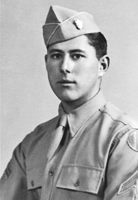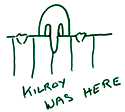The Stamford Historical Society Presents
Pride and Patriotism: Stamford’s Role in World War II
Online Edition
The Interviews
Morton Johnson
Morton Johnson signed up with the army infantry in 1942. After receiving training he remained in the states as an infantry instructor for a year. He went the Officer Cadet School and after reaching the rank of 2nd Lt. was shipped off as a replacement. He landed as a platoon leader on Okinawa on April 1st 1945. He was wounded twice during his few months of combat and ended the war stationed on Hawaii.
 I was working in Stamford with my father, a little business on State Street, when the war began. My name was in draft but I applied right away. I took an exam, and they took me even with a missing finger, didn’t make any difference. We taught guys to fire without a trigger finger…that’s when I went in December ‘42, I shipped to Fort Devins, Massachusetts, it was cold, and they put all new guys on guard duty. We were there a week or so, exams etc., uniforms were given out, then they shipped us to Camp Croft, Spartanburg, SC. We went through the infantry basic training. They kept me back as a cadreman and I spent two years there, really learned the material, did some teaching, got to make sergeant. It was an Infantry replacement training center. Infantry tactics I taught, included close order, hand to hand combat, range rifle work: how to shoot, walk, dig a foxhole… in 3 months we trained people to be able to walk 30 miles.
I was working in Stamford with my father, a little business on State Street, when the war began. My name was in draft but I applied right away. I took an exam, and they took me even with a missing finger, didn’t make any difference. We taught guys to fire without a trigger finger…that’s when I went in December ‘42, I shipped to Fort Devins, Massachusetts, it was cold, and they put all new guys on guard duty. We were there a week or so, exams etc., uniforms were given out, then they shipped us to Camp Croft, Spartanburg, SC. We went through the infantry basic training. They kept me back as a cadreman and I spent two years there, really learned the material, did some teaching, got to make sergeant. It was an Infantry replacement training center. Infantry tactics I taught, included close order, hand to hand combat, range rifle work: how to shoot, walk, dig a foxhole… in 3 months we trained people to be able to walk 30 miles.
I took a year to become teacher. I went from cadreman to corporal then I was assigned as sergeant with a platoon.
I was not part of a division etc. I applied to OCS (officer cadet school) and shipped to Ft. Benning, Columbus, GA. It was a 3 1/2 month course, then I shipped out as a replacement 2nd Lieutenant, who had high mortality rates. Initially I was shipped to Hawaii, about 1944, I was not shipped out with my classmates,
I joined the 7th division 32 regiment and only lasted a few months. I was wounded twice, there were only 50 unscathed out of 200 in my group at Okinawa. I went by train to Seattle WA, then we were assembled and put on the boat to Hawaii. We were in Seattle only 2-3 weeks, no training, just waiting.
At Hawaii we were distributed to organizations short platoon leaders…most were replacing leaders wounded or killed. They flew me to Kwajalein, then later drove me down the army beach and there was my company. I walked right in to head the platoon.
It was unnerving…2nd Lieutenants didn’t know what the platoon men did…the men are glad to see you, especially the platoon sergeant, but it was a half-hearted welcome. I knew what I should be doing, infantry school had had a marvelous curriculum…things happen just as they should in the textbook…I had to shape up right away and start giving orders. I met the platoon at Leyte to do dry landing practice…got very seasick.. We practiced for Okinawa. We were there for a few weeks…April 1 was the landing at Okinawa.
I made terrible entrance…soon as on the landing craft, I was weezy and couldn’t stand I was seasick…In end my guys picked me up and threw me on the beach.
There was no opposition on Okinawa landing. Japanese suffered great casualties on landings generally because of the US Navy which would blast the coasts with 16" shells so there was no opposition at Okinawa. We assembled, organized and moved out.
It was nice weather…Japanese couldn’t mass artillery like the US but…sniped with 77s .
We had to go through the island of Okinawa just on the edge of the airport. There were a series of small encounters. We got organized as we were turning south, after only a week or two we were through and the captain sent me with a patrol into a town to see what was there. All was hidden from view.
I took squad walked into town…it had been prepared, we had used artillery fire and had covered anything that was there, but we ran into a squad of Japanese soldiers that were killed. We walked through town, there were no armaments, no one dug in. We determined it was secure, Our main force was high on a hill looking down into town. We were lucky that there was no opposition, a squad is only 12 men. Next day we were hit by their artillery, but it didn’t continue long. Most people who fight never see the front, one out of every 10 soldiers does the fighting the other 9 are supply support.
I did not see any living Japanese---none, we just got hit by their artillery. One scary thing happened when I went dig hole to go to the bathroom, and saw Japanese tracks but no troops…
At night there were infiltrations. The Navy fired star shells to light up the entire ground…most of us on the ground did not fire so as not to reveal our position. One fired across the front again so as not to reveal one’s position. This was important as sometimes we even got dived bombed by our own Navy.
We took a town on the heights…but while on patrol we were shot by artillery and I got hit by a piece of shrapnel. I had no idea how badly and feared bleeding to death…it hit me in the back. One of the guys put a dressing on it, and in the hospital sewed me up then back to platoon.
I had to watch the guys to make sure they always chose a defensible position. The 2nd Lieutenant’s job is to see to men’s protection.
During my last engagement, we were to take this hill. I saw the Japanese, but never face to face, bombardments were over the hill back and forth. We never took any prisoners. That night I crept up to the top to see…right over hill was a dead Jap officer. I took his sword and pistol…next morning we advanced through a series of Jap dugouts…the snipers were now behind us…there we are on side of hill, first thing in the morning they opened up and went right down the line. I got hit in the back again.
Then I was evacuated, my total field time was only a couple months all on Okinawa. No one was killed or wounded in the platoon but me. I was looking around…the Sergeant took over again. Only 50 out of 200 men were unscathed of his group.
When I left Okinawa the northern part of the island was taken and the Japanese were crowded on escarpments on the southern end of Island.
I was sent to Hawaii on a hospital ship…I spent a couple months recuperating at Scofield barracks…then I was assigned to an APO on Maui, a great duty, relieving a HQ commandant APO army post office…
The whole time in the field, communication was mostly by messengers…usually we dug holes to sleep in under the stars. I recall once walking through a town and seeing a bunch of natives running down the side of hill and I asked the sergeant who they were and he said it looked like the people who lived there. But they weren’t, it was a group of some Japanese with a machine guns with some native and they set up in the woods and 15 minutes later they opened up and here we are caught into open. I dove behind a rock and they peppered it for 5 minuets then stopped and that was it.
We didn’t like to see anyone left behind us, even the natives because there was no way of knowing where their loyalty was…we told them to go…when the didn’t go, they got shot. It did not seem like a liberation for Okinawans.
I stayed in Hawaii till after peace treaty then went home.
I had a replacement once come in had to get rid of him, snored so loudly could here him 100 yards away…sent him back.
The huge battle for Okinawa started after I left.
We had to censor all the mail…I envied people from Midwest and south…their faith that God would take care of them…I didn’t have that.
Jap Air force was only a harassment.
 Introduction
Introduction
Veterans
Battles
Stamford Service Rolls
Homefront
Exhibit Photos
Opening Day

